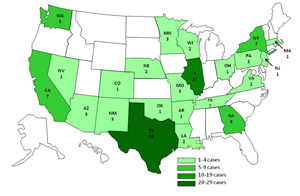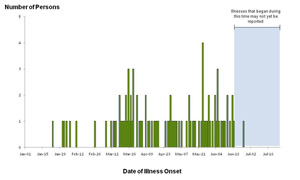Investigation Update: Multistate Outbreak of Human Salmonella Agona Infections Linked to Whole, Fresh Imported Papayas
July 26, 2011
On this Page
Today's Highlights
- A total of 99 individuals infected with the outbreak strain of Salmonella Agona have been reported from 23 states.
- Epidemiologic, traceback, and laboratory investigations have linked this outbreak to eating fresh, whole papayas imported from Mexico by Agromod Produce, Inc. of McAllen, Texas.
- On July 23, 2011, Agromod Produce, Inc. of McAllen, Texas voluntarily recalled fresh, whole papayas because they have the potential to be contaminated with Salmonella. These fresh, whole papayas were imported from Mexico and distributed nationwide and to Canada through retail stores and wholesalers. For more information, please see Agromod Produce, Inc. recall announcement on FDA’s website.
- Contaminated papayas may still be in grocery stores and in consumers' homes.
- Consumers should not eat recalled papayas, and restaurant and food service operators should not serve them.
Introduction
CDC and the U.S. Food and Drug Administration (FDA) are collaborating with public health officials in Texas, Illinois, Georgia, and other states to investigate a multistate outbreak of Salmonella Agona infections linked to whole, fresh imported papayas. Public health investigators are using DNA “fingerprints” of Salmonella bacteria obtained through diagnostic testing with pulsed-field gel electrophoresis, or PFGE, to identify cases of illness that may be part of this outbreak. They are using data from PulseNet, the national subtyping network made up of state and local public health laboratories and federal food regulatory laboratories that performs molecular surveillance of foodborne infections.
A total of 99 individuals infected with the outbreak strain of Salmonella Agona have been reported from 23 states between January 1 and July 22, 2011. The number of ill persons identified in each state with the outbreak strain is as follows: Arkansas (1), Arizona (3), California (7), Colorado (1), Georgia (8), Illinois (17), Louisiana (2), Massachusetts (1), Minnesota (3), Missouri (3), Nebraska (2), Nevada (1), New Jersey (1), New Mexico (3), New York (7), Ohio (1), Oklahoma (1), Pennsylvania (2), Tennessee (1), Texas (25), Virginia (2), Washington (5), and Wisconsin (2).
Among persons for whom information is available, illnesses began on or after January 17, 2011. Ill persons range in age from less than 1 year old to 91 years old, and the median age is 19 years old. Forty-one percent of patients are younger than 5 years old. Sixty percent are female. Eleven persons reported travel to Mexico in the week before they became ill. Ten patients were hospitalized. No deaths have been reported.
The outbreak can be visually described with a chart showing the number of people who became ill each day. This chart is called an epi curve. The number of reported cases increased slowly from January to June 2011. Illnesses that occurred after June 19, 2011, might not be reported yet due to the time it takes between when a person becomes ill and when the illness is reported. This takes an average of 2 to 3 weeks. Please see the Timeline for Reporting of Salmonella Cases for more details.
Investigation of the Outbreak
Epidemiologic, traceback, and laboratory investigations conducted by officials in many local, state, and federal public health, agriculture, and regulatory agencies have linked this outbreak to eating fresh, whole papayas imported from Mexico by Agromod Produce, Inc. of McAllen, Texas. Among 52 ill persons for whom information is available, 57% have reported consuming papayas in the week before illness onset. This is significantly different compared to results from a survey of healthy persons in which 11% of persons of Hispanic/Latino ethnicity and 3% of non-Hispanic/Latino ethnicity reported consuming papaya in the 7 days before they were interviewed. Product information such as date and location of purchase of papayas were collected from ill persons and used by local, state, and federal public health, agriculture, and regulatory agencies to conduct traceback investigations. Agromod Produce, Inc. was identified as a common supplier of papayas purchased by ill persons.
Sampling of papayas by FDA identified two samples with Salmonella Agona that were indistinguishable by PFGE from the outbreak strain. One sample was collected at Agromod Produce, Inc. in McAllen, Texas and the other was collected at the United States border destined for Agromod Produce, Inc. These papayas had been imported from Mexico. The shipments from which Salmonella was isolated were not distributed in the United States. FDA is working closely with Agromod Produce Inc. and with Mexican health officials to determine how the papayas became contaminated.
The strain of Salmonella Agona associated with this outbreak is comprised of four closely related PFGE patterns that have been rarely identified before in PulseNet. Three of these four PFGE patterns were first identified beginning in 2010. A total of 119 cases from 14 states were reported between May 28, 2010, and September 10, 2010. Distribution of age, sex, ethnicity, and state of residence among ill persons was similar to the distribution seen in the current outbreak. Despite an intensive investigation during the summer of 2010 by local, state, and federal public health agencies that focused on fresh fruit, including papaya, the source of the outbreak was not determined.
Clinical Features/Signs and Symptoms
Most persons infected with Salmonella bacteria develop diarrhea, fever, and abdominal cramps 12 to 72 hours after infection. The illness usually lasts 4 to 7 days, and most persons recover without treatment. However, in some persons, the diarrhea may be so severe that the patient needs to be hospitalized. Salmonella infection may spread from the intestines to the bloodstream and then to other body sites and can cause death unless the person is treated promptly with antibiotics. Older adults, infants, and those with impaired immune systems are more likely to have a severe illness from Salmonella infection. More general information about Salmonella can be found here.
Recall Information
On July 23, 2011, Agromod Produce, Inc. of McAllen, Texas voluntarily recalled fresh, whole papayas because they have the potential to be contaminated with Salmonella. The recall includes all Blondie, Yaya, Mañanita, and Tastylicious Brand papayas sold prior to July 23, 2011. Each Blondie Brand papaya can be identified by a blue and orange sticker label with green and white lettering on the fruit that states Blondie 4395 Mexico. The Yaya Brand Papayas can be identified by a yellow, red, orange, and green label with white, green, and red lettering that reads Yaya Premium Papayas Yaya PLU-4395 Mexico. Each Mañanita Brand Papaya can be identified by a green, yellow, and red sticker label that states Mexico Mañanita 4395. The Tastylicious Brand Papayas can be identified by a white and blue sticker with red and white lettering that states 4395 Tastylicious Mexico. These fresh, whole papayas were imported from Mexico and distributed nationwide and to Canada through retail stores and wholesalers.
Advice to Consumers, Retailers, and Others
Contaminated papayas may still be in grocery stores and in consumers' homes.
- Consumer should not eat recalled papayas, and restaurant and food service operators should not serve them.
- Consumers who have papayas in their homes can check with the place of purchase to determine if the fruit came from Agromod Produce, Inc.
- Recalled papayas should be disposed of in a closed plastic bag placed in a sealed trash can. This will prevent people or animals from eating them.
- Persons who think they might have become ill from eating possibly contaminated papayas should consult their health care providers.
- Consumers and food preparers should wash their hands before and after handling any papayas. Rinse the papayas under running water, and then dry them with a clean cloth or paper towel before cutting. Promptly refrigerate cut papayas.
CDC's Role in Food Safety
CDC leads federal efforts to gather data on foodborne illnesses, investigate foodborne outbreaks and monitor the effectiveness of prevention and control efforts. CDC is not a food safety regulatory agency but works closely with the food safety regulatory agencies, in particular, with FDA and U.S. Department of Agriculture’s Food Safety and Inspection Service. CDC also plays a key role in building state and local health department epidemiology, laboratory and environmental health capacity to support foodborne disease surveillance and outbreak response. Notably, CDC data can be used to help document the effectiveness of regulatory interventions.
Previous Updates
Get email updates
To receive email updates about this page, enter your email address:
Contact Us:
- Centers for Disease Control and Prevention
1600 Clifton Rd
Atlanta, GA 30333 - 800-CDC-INFO
(800-232-4636)
TTY: (888) 232-6348 - New Hours of Operation
8am-8pm ET/Monday-Friday
Closed Holidays - cdcinfo@cdc.gov




